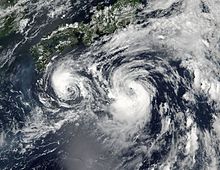Fujiwhara effect

The Fujiwhara effect (also described as Fujiwhara interaction ) is a type of mutual influence by two hurricanes . Both systems seem to orbit each other.
As the two cyclones approach each other, the two centers of the storms begin to revolve around a point between the two systems. The two eddies attract each other and move on a spiral path around this pivot point. Ultimately, there may be a merger. If the two storm systems are of different sizes, the larger cyclone will dominate the interaction and the smaller storm will revolve around the larger one.
The effect is often used in relation to the movement of tropical cyclones, although in the end the merging is a rather unusual process. This effect is generally spoken of when the two storm systems are closer than about 1450 km to each other and at least as strong as a tropical storm.
The effect was named after the Japanese meteorologist Sakuhei Fujiwara ( 藤原 咲 平 , English also Fujiwhara ; 1884-1950), who described it for the first time in 1921 in an essay on the movement of air vortices over water.
Examples
Some examples can be found in the brisk 1995 Atlantic hurricane season . At the height of the season, the Fujiwhara effect first became apparent when hurricanes Humberto and Iris met . Iris then came under the influence of a third storm, Karen , which initially circled Iris and eventually merged with Iris. During the 1994 typhoon season , typhoons Pat and Ruth completed a full orbit around their centroid before collapsing into a single cyclone. In 1997 the super typhoons Ivan and Joan were a pair of super typhoons, the course of which was determined by the Fujiwhara effect. Ivan was steered on a westerly course and Joan on a more northerly course.
In 2005, tropical storm Alpha was absorbed by Hurricane Wilma in the North Atlantic , just as Lidia was absorbed by Max. During the 2007 typhoon season, the Fujiwhara effect in the South China Sea reversed the course of Typhoon Hagibis towards Typhoon Mitag , located northeast of the Philippines .
Typhoon Melor, east of the Philippines, also caused typhoon Parma, which had already crossed the Philippines, to reverse the direction of migration during the 2009 typhoon season . Typhoon Parma crossed north of Luzon a second time, from west to east. Typhoon Melor meanwhile withdrew to the north, whereby Typhoon Parma escaped the influence of Typhoon Melor. Parma therefore resumed its original direction of migration to the west and subsequently crossed Luzon for the third time.
swell
- USA Today . "Fujiwhara effect describes a stormy waltz" . (Accessed January 31, 2015, English)
- Joint Typhoon Warning Center . Joint Typhoon Warning Center - Typhoon Pat ( Memento of November 29, 2007 in the Internet Archive ). 1994. (PDF accessed on August 12, 2015, English)
- Edward N. Rappaport, NOAA Hurricane Research Division. "Hurricane Iris Preliminary Report"
- National Hurricane Center . "Tropical Cyclone Report Lisa" (2004). (Accessed January 25, 2008, English)
